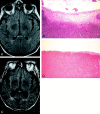Focal lesion in the splenium of the corpus callosum on FLAIR MR images: a common finding with aging and after brain radiation therapy
- PMID: 12748085
- PMCID: PMC7975819
Focal lesion in the splenium of the corpus callosum on FLAIR MR images: a common finding with aging and after brain radiation therapy
Abstract
Background and purpose: Focal high signal intensity in the splenium of the corpus callosum on fluid-attenuated inversion-recovery (FLAIR) images is generally considered an abnormal MR finding. We identified high signal intensity in the splenium on FLAIR images in patients of advanced age with otherwise normal images and in patients who had received brain radiation therapy. We undertook an investigation to determine the frequency of this finding in these patient groups.
Methods: We reviewed the FLAIR images and medical records of 67 patients (group 1) imaged for suspicion of CNS disease and of 18 consecutive patients (group 2) with history of brain radiation therapy. All FLAIR images were evaluated for focal signal intensity abnormalities in the splenium and for diffuse white matter abnormalities. Also, autopsy specimens from two cases not part of either study group were examined.
Results: Among the initial 67 patients in group 1, focal high signal intensity in the splenium was associated with aging, radiation therapy, and white matter changes. Focal high signal intensity in the splenium was evident on FLAIR images in 16 of the 18 patients in the post-radiation therapy group. Histologic examination of the splenium in one autopsy case with a history of chest and neck radiation therapy demonstrated isomorphic gliosis.
Conclusion: High signal intensity in the splenium of the corpus callosum on FLAIR images is a common finding after brain radiation therapy and can be seen with aging. The radiologist should be aware of this common finding and not mistake it for more commonly recognized causes of splenial lesions.
Figures



Comment in
- AJNR Am J Neuroradiol. 2004 Apr;25(4):664-5
-
Mid-anterior surface of the callosal splenium: subependymal or subpial?AJNR Am J Neuroradiol. 2004 Apr;25(4):664-5. AJNR Am J Neuroradiol. 2004. PMID: 15090365 Free PMC article. No abstract available.
Similar articles
-
Focal Lesion in Splenium of Corpus Callosum on FLAIR MRI: Common Findings in Aged Patients.Neuroradiol J. 2006 Jun 30;19(3):301-5. doi: 10.1177/197140090601900305. Epub 2006 Jun 30. Neuroradiol J. 2006. PMID: 24351214
-
Focal lesion in the splenium of the corpus callosum in epileptic patients: antiepileptic drug toxicity?AJNR Am J Neuroradiol. 1999 Jan;20(1):125-9. AJNR Am J Neuroradiol. 1999. PMID: 9974067
-
[Clinical features and neuroimaging findings of 12 patients with acute disseminated encephalomyelitis involved in corpus callosum].Zhonghua Yi Xue Za Zhi. 2012 Nov 20;92(43):3036-41. Zhonghua Yi Xue Za Zhi. 2012. PMID: 23328373 Chinese.
-
Transient focal lesion in the splenium of the corpus callosum: MR imaging with an attempt to clinical-physiopathological explanation and review of the literature.Radiol Med. 2007 Sep;112(6):921-35. doi: 10.1007/s11547-007-0197-9. Epub 2007 Sep 20. Radiol Med. 2007. PMID: 17885738 Review. English, Italian.
-
Lesions in the Splenium of the Corpus Callosum on MRI in Children: A Review.J Neuroimaging. 2017 Nov;27(6):549-561. doi: 10.1111/jon.12455. Epub 2017 Jun 27. J Neuroimaging. 2017. PMID: 28654166 Review.
Cited by
-
The association of regional white matter lesions with cognition in a community-based cohort of older individuals.Neuroimage Clin. 2018 Mar 29;19:14-21. doi: 10.1016/j.nicl.2018.03.035. eCollection 2018. Neuroimage Clin. 2018. PMID: 30034997 Free PMC article.
-
Advancing Beyond the Hippocampus to Preserve Cognition for Patients With Brain Metastases: Dosimetric Results From a Phase 2 Trial of Memory-Avoidance Whole Brain Radiation Therapy.Adv Radiat Oncol. 2023 Aug 10;9(2):101337. doi: 10.1016/j.adro.2023.101337. eCollection 2024 Feb. Adv Radiat Oncol. 2023. PMID: 38405310 Free PMC article.
-
Acquired lesions of the corpus callosum: MR imaging.Eur Radiol. 2006 Apr;16(4):905-14. doi: 10.1007/s00330-005-0037-9. Epub 2005 Nov 12. Eur Radiol. 2006. PMID: 16284771 Review.
-
Characterization of white matter degeneration in elderly subjects by magnetic resonance diffusion and FLAIR imaging correlation.Neuroimage. 2009 Aug;47 Suppl 2:T58-65. doi: 10.1016/j.neuroimage.2009.02.004. Epub 2009 Feb 20. Neuroimage. 2009. PMID: 19233296 Free PMC article.
-
Reversible splenial abnormality in hypoglycemic encephalopathy.Neuroradiology. 2007 Mar;49(3):217-22. doi: 10.1007/s00234-006-0184-y. Epub 2006 Nov 30. Neuroradiology. 2007. PMID: 17136534
References
-
- Friese SA, Bitzer M, Freudenstein D, et al. Classification of acquired lesion of the corpus callosum with MRI.Neuroradiology 2000;42:795–802 - PubMed
-
- Tsuruda JS, Kortman KE, Bradley WG, et al. Radiation effects on cerebral white matter.AJR Am J Roentgenology 1987;149:165–171 - PubMed
-
- Coffey CE, Wilkinson WE, Parashos IA, et al. Quantitative cerebral anatomy of the aging human brain: a cross-sectional study using magnetic resonance imaging.Neurology 1992;42:527–536 - PubMed
-
- Pantoni L, Garcia JH. Pathogenesis of leukoaraiosis.Stroke 1997;28:652–659 - PubMed
-
- Pantoni L, Garcia JH. The significance of cerebral white matter abnormalities 100 years after Binwanger’s report: a review.Stroke 1995;26:1293–1301 - PubMed
MeSH terms
LinkOut - more resources
Full Text Sources
Medical
